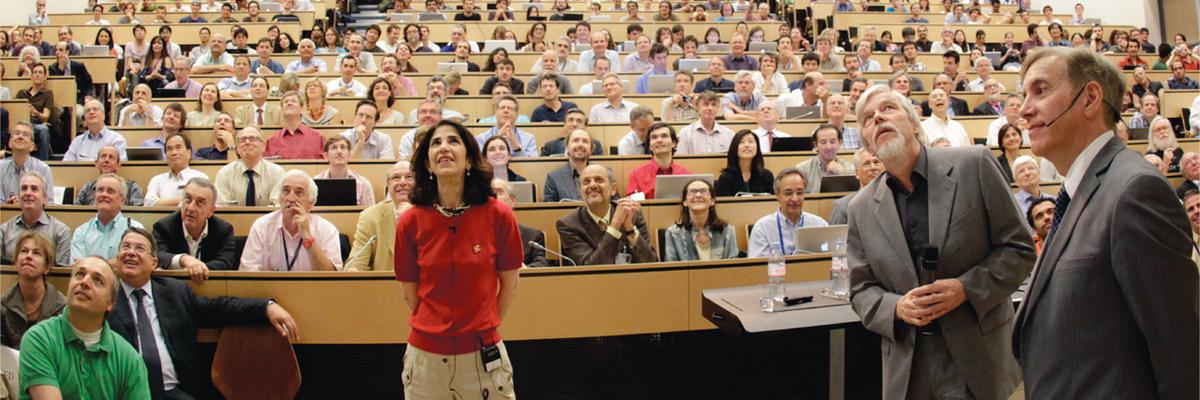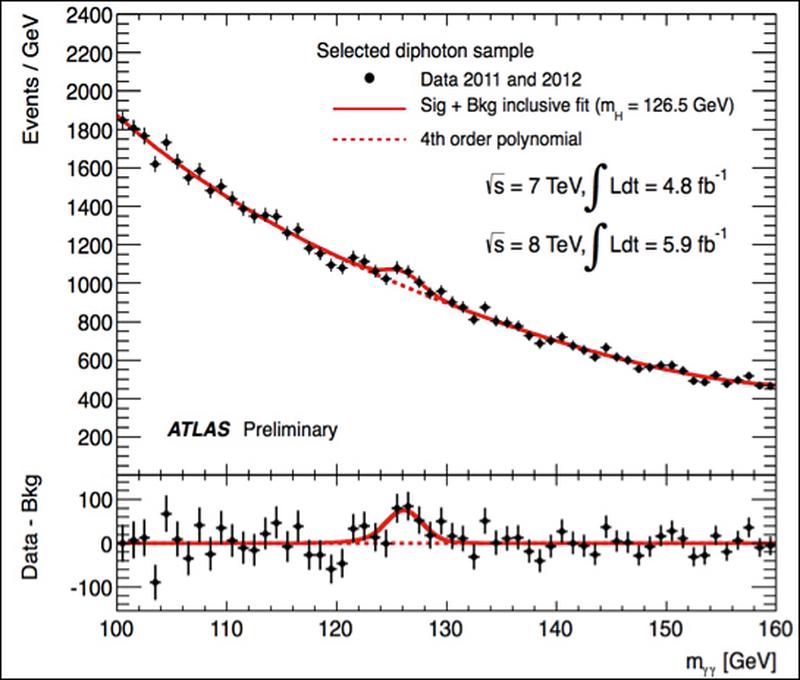Highlight
The Higgs boson, ten years after its discovery
July 4, 2022
The landmark discovery of the Higgs boson at the LHC exactly ten years ago, and the progress made since then to determine its properties, have allowed physicists to make tremendous steps forward in our understanding of the universe.
The Collider Physics Group at IFAE joined the ATLAS collaboration since its inception. For 30 years it has contributed to the design and construction of the experiment and the physics analysis program.

Ten years ago, on July 4 2012, the ATLAS and CMS collaborations at the Large Hadron Collider (LHC) announced the discovery of a new particle with features consistent with those of the Higgs boson. The discovery was a landmark in the history of science and captured the world’s attention. One year later it won François Englert and Peter Higgs the Nobel Prize in Physics for their prediction made in the 60s, together with the late Robert Brout, of a new fundamental field, known as the Higgs field, that pervades the universe, manifests itself as the Higgs boson and gives mass to the elementary particles.
“The discovery of the Higgs boson was a monumental milestone in particle physics. It marked both the end of a decades-long journey of exploration and the beginning of a new era of studies of this very special particle,” says Fabiola Gianotti, CERN’s Director-General and the project leader (‘spokesperson’) of the ATLAS experiment at the time of the discovery. “I remember with emotion the day of the announcement, a day of immense joy for the worldwide particle physics community and for all the people who worked tirelessly over decades to make this discovery possible.”
The new journey so far
The new particle discovered by the international ATLAS and CMS collaborations in 2012 appeared very much like the Higgs boson predicted by the Standard Model. But was it actually that long-sought-after particle? As soon as the discovery had been made, ATLAS and CMS set out to investigate in detail whether the properties of the particle they had discovered truly matched those predicted by the Standard Model.
By using data from the disintegration, or ‘decay’, of the new particle into two photons, the experiments have demonstrated that the new particle has no intrinsic angular momentum, or quantum spin, exactly like the Higgs boson predicted by the Standard Model. By contrast, all other known elementary particles have spin.

By observing the Higgs bosons being produced from and decaying into pairs of W or Z bosons, ATLAS and CMS confirmed that these gain their mass through their interactions with the Higgs field, as predicted by the Standard Model.
The experiments have also demonstrated that the top quark, bottom quark and tau lepton, which are the heaviest fermions, obtain their mass from their interactions with the Higgs field, again as predicted by the Standard Model. These observations also confirmed the existence of an interaction, or force, called the Yukawa interaction, which is part of the Standard Model but is unlike all other forces in the Standard Model: it is mediated by the Higgs boson, and its strength is not quantized, that is, it doesn’t come in multiples of a certain unit.
ATLAS and CMS measured the Higgs boson’s mass to be 125 billion electronvolts (125 GeV), with an impressive precision of almost one per mil. Knowing this value is important because, together with the mass of the heaviest known elementary particle, the top quark, and other parameters, the Higgs boson’s mass may determine the stability of the universe’s vacuum.
The Collider Physics group at IFAE contribution
The Collider Physics group at IFAE joined the ATLAS collaboration since its inception in 1992 at the time various large detectors were designed and international collaborations were formed. IFAE developed jointly with a few other institutes a new concept of hadron calorimeter to detect the collimated jets of particles produced in the proton-proton collisions and built a full quarter of the detector in its workshop a large wheel of 4m outer radius imbedded in the huge ATLAS detector. The calorimeter was one of the first parts of the detector to be installed in the underground cavern in 2005.
The amount of collisions produced at the LHC is so large, that not all the information can be recorded. A trigger system is needed to select the interesting collisions like the ones susceptible to contain a Higgs boson. IFAE contributed to the design of the software running in a large computer farm part of that system, a novelty at the time.
The search for the Higgs, in a broad window of possible mass, started on day-1 together with all the other analysis. At the end of the first in 2011, the existence of the SM Higgs was excluded in a window range except in an interval around 120 GeV. Was this a hint of the Higgs or a simple statistical fluctuation? We had to wait for the next round of data-taking in 2012. The expectation was at the maximum. The two large experiments ATLAS and CMS were working in parallel at maximum speed without disclosing their data. It took until July 4th when both experiments could make their historic announcement of consistent observation of a Higgs boson with mass of 125 GeV.
During these intense years IFAE played important roles in the governance of the collaboration. It held convenerships of many working groups, as well as the presidency of the collaboration board of the 160 institutions that was held twice by IFAE out of the 10 presidencies.

The journey that still lies ahead
What’s left to be learned about the Higgs field and the Higgs boson ten years on? A lot. Does the Higgs field also give mass to the lighter fermions or could another mechanism be at play? Is the Higgs boson an elementary or composite particle? Can it interact with dark matter and reveal the nature of this mysterious form of matter? What generates the Higgs boson’s mass? Does it have ‘twins’ or ‘relatives’?
Finding the answers to these and other intriguing questions will not only further our understanding of the universe at the smallest scales but may also help unlock some of the biggest mysteries of the universe as a whole, such as how it came to be the way it is and what its ultimate fate might be. “The Higgs boson itself may point to new phenomena, including some that could be responsible for the dark matter in the universe,” says CMS spokesperson Luca Malgeri. “ATLAS and CMS are performing many searches to probe all forms of unexpected processes involving the Higgs boson.”
While answers to some of these questions might be provided by data from the imminent third run of the LHC or in other periods of accelerator operation, answers to other enigmas are thought to be beyond the reach of the LHC, requiring a future “Higgs Factory”. For this reason, CERN and its international partners are investigating the technical and financial feasibility of a much larger and more powerful machine, the Future Circular Collider (FCC ).
“High-energy colliders remain the most powerful microscope at our disposal to explore nature at the smallest scales and to discover the fundamental laws that govern the universe,” says Gian Giudice, head of CERN’s Theory department.
The Spanish Research Community contribution
The Spanish research community plays a very important role in the ATLAS and CMS collaborations at CERN, the experiments that announced the Higgs boson discovery on the 4th of July, 2012.
Since the start-up of the ATLAS detector, researchers from the Instituto de Física de Altas Energías (IFAE ), Instituto de Física Corpuscular (IFIC ), Instituto de Microelectrónica de Barcelona (IMB-CNM ) and from the Universidad Autónoma de Madrid (UAM ) have been closely involved in this experiment.
On the other hand, the national presence has also been prominent in the CMS programme since the beginning of this experiment, with the participation of research groups from the Centro de Investigaciones Energéticas, Medioambientales y Tecnológicas (CIEMAT ), Instituto de Física de Cantabria (IFCA ), Universidad Autónoma de Madrid (UAM ) and the Universidad de Oviedo (UO ). More recently, researchers from the Instituto Tecnológico de Aragón (ITAINNOVA ) and the Centro Nacional de Microelectrónica (CNM ) have joined the CMS collaboration.
- IFAE Research group
- Collider Physics Group
- Contact
